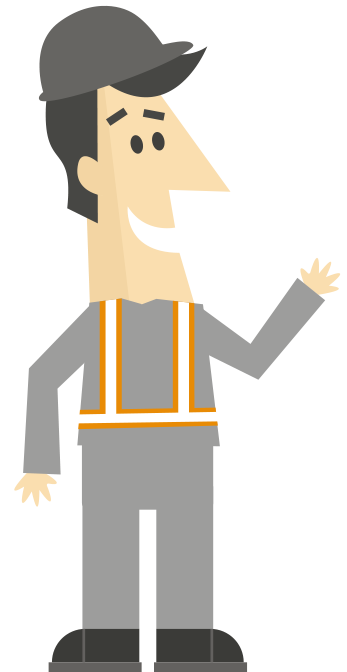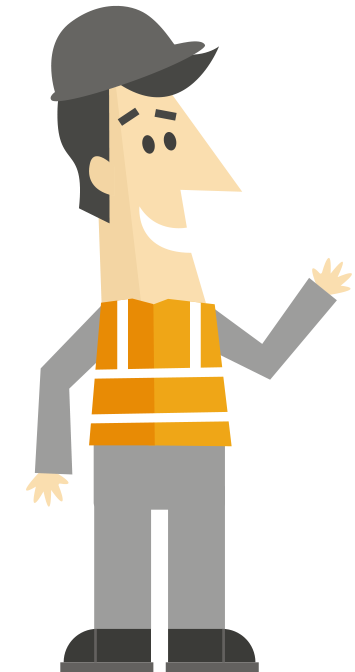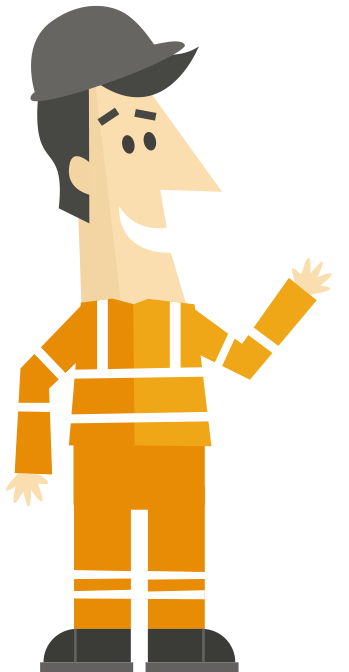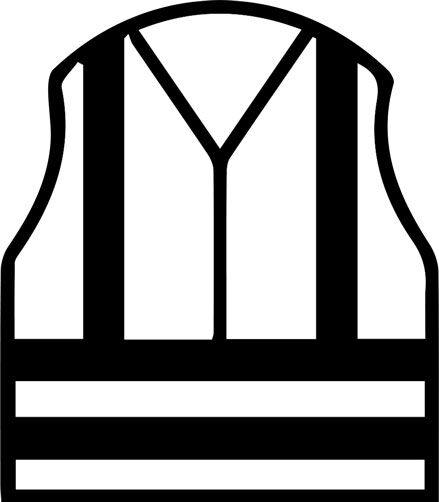Reflective clothing EN ISO 20471
The most important rules regarding choice of reflective clothing for business use
The employer must provide reflective clothing for employees who carry out work in traffic, such as road work, rescue work, supervision work, unloading of goods and refuse collection, if the work situation requires that the employees can be clearly seen during work, whether this is during the day or night. The employer must instruct the employees when and how to wear reflective clothing and ensure that employees wear the reflective clothing when working outside vehicles or in designated areas.
Reflective wear
Reflective wear is personal protective equipment made from a boldly coloured fabric in fluorescent yellow, orange or red, which makes you very visible in daylight, so you avoid blending into your surroundings. The material also reflects light from, e.g. car headlights. Reflectors must be approved and applied so that you are best seen in the dark. The EN ISO 20471 standard only allows workwear with Class 2 reflectors to be approved.
Reflective clothing is divided into three classes depending on how much coloured material and reflective material the clothing is made of. Class 1 reflective clothing has the lowest visibility and Class 3 reflective clothing has the highest visibility.
- EN ISO 20471-1 - minimum 0.14 m² fluorescent material and minimum 0.10 m² reflective material.
- EN ISO 20471-2 - minimum 0.50 m² fluorescent material and minimum 0.13 m² reflective material.
- EN ISO 20471-3 - minimum 0.80 m² fluorescent material and minimum 0.20 m² reflective material.
See all Class 1 workwear for men here. Find similar reflective clothing in class 1 for women here
See all Class 2 workwear for men here. See also the selection of reflective clothing in class 2 for women here
See all Class 3 workwear for men here. Reflective clothing in class 3 for women can be found here
Requirements applicable to all three safety classes of reflective clothing
- The clothing must be visible during both the day and night.
- The clothing must be visible from all sides.
- The reflectors must be positioned on the clothing in such a way that they highlight the outline of the wearer, so it is immediately clear to the driver of a vehicle that it is a person and not e.g. a road sign.
You can achieve class 3 safety workwear in different ways; by using class 3 workwear, or combining two items of class 2 workwear, which when worn together achieve class 3 certification.
Reflective wear must be CE marked and therefore comply with the rules on the design and function of personal protective equipment. Visibility requirements are considered to be met if the clothing has been tested and classified according to the DS/EN ISO 20471 standard. Reflective wear produced according to the previous standard, DS/EN 471, may still be used, but combining the articles marked DS/EN 471 with the new standard to obtain Class 3 clothing is not permitted.
Washing
Reflective clothing produced according to the standards is marked with a pictogram, as well as information on the class of clothing and the number of times you can wash it without the reflective effect being diminished. Be sure to keep your safety clothing clean, as it is not safe otherwise. It must not be washed more than is stated on the product, otherwise the reflective properties do not meet the requirements and are not reflective enough.
Choice of reflective clothing
Choosing the right reflective clothing is dependent on an overall risk assessment. The first step is to assess the speed of the surrounding traffic: The faster the traffic, the higher the class of reflective clothing. Then, the aggravating factors in the specific situation are assessed to determine whether the chosen class is sufficient or whether a higher class is necessary. Finally, we consider whether there are other factors to consider when choosing reflective clothing. If the need varies, we recommend purchasing Class 3 high visibility clothing. If in doubt about the class, Class 3 should be chosen.
Choosing reflective clothing based on traffic speed:
- Class 1 reflective clothing - or higher class - is selected if the surrounding traffic speed is approx. 30 km/h (approx. 20 mph) or less.
- Class 2 reflective clothing - or higher class - is selected if the surrounding traffic speed is between approx. 30 and 60 km/h (approx. 20 - 50 mph) .
- Class 3 reflective clothing is chosen if the surrounding traffic speed is over approx. 60 km/h (approx. 50 mp/h).
Examples of aggravating factors
Poor driving conditions/visibility for the driver due to snow, ice, darkness, strong backlight, fog, rain or lack of street lighting, construction sites with uneven ground and when working at a height. Heavy traffic and work around large, heavy vehicles.
The Danish Working Environment Authority requires the use of Class 1, 2 and 3 hi-vis clothing in the following situations
Class 1
When accompanied visitors are frequenting areas in which you are required to wear Class 2 or Class 3 hi-vis clothing while working.
When employees, such as refuse collectors, carry out work along the roadway, during which they only emerge onto the carriage way in close proximity to a refuse truck or similar vehicle, which is clearly marked in accordance with the provisions of the Danish Road Traffic Act. Higher grade hi-vis clothing should be used if the conditions are not met.
Class 2
When supervisors oversee work requiring the use of Class 3 hi-vis clothing.
In the case of road works where work is carried out within a designated area, but where the risk of collision cannot be completely excluded
For types of work other than road work, in areas with no effective separation for oncoming traffic, and where effective measures have ensured that oncoming traffic such as motor vehicles, motor implements, etc., slows down the driving speed to a safe and reasonable speed.
Class 3
In the case of road work, in which you move outside of the designated area in connection with the work carried out.
For other work on roads without surface marking or physical separation from the driving traffic, and where there will be traffic driving at normal driving speeds.
When working in port areas in places with traffic such as motor vehicles, motorised equipment, and so on.
In the case of working in road and/or rail tunnels, when the work requires moving outside of the designated barriers, even when the only traffic is that which is connected to the work itself.
When working on or near railroad tracks in use, where there is no effective physical separation from the track. Note that there are special rules for railway track work with regard to colour selection!
If the requirement varies, we recommend purchasing Class 3 hi-vis clothing. This might consist of two pieces of Class 2 hi-vis clothing, such as trousers worn with a jacket or vest. Important: See the above explanation for combining Hi-Vis clothing.
In addition, when choosing reflective clothing, the employer must:
Assess whether the reflective clothing should protect against other hazards such as fire, sparks, cold or cutting damage. The retailer of the reflective clothing may state which reflective clothing is suitable to meet these kinds of additional protection needs.
Make sure the reflective clothing fits the employee. This is achieved, for example, by allowing the employee to choose between different sizes and designs - for example, between a full suit or trousers + jacket/vest. It is also important that the reflective clothing is comfortable. Trousers and jackets must not be shortened, as this compromises the area of fluorescent fabric needed for the item’s approval. Many trousers are available in several leg lengths. There must be a minimum of 5 cm from the lower reflector to the hem of the trousers!
Make sure the reflective clothing is suitable for the work being carried out. It is also important that the clothing is robust enough to allow it to be washed/cleaned at appropriate intervals.
Inform the employee that the jacket and vest must be fastened at the front in order to be classified. The reflectors must not be broken. Alternatively, the employee must wear a sweatshirt or T-shirt with reflectors underneath the jacket or vest. Please note that size XS and S are sometimes a Class lower due to the small area of fluorescent material.
Please note that classification must be maintained when applying print and embroidery. Large-scale printing reduces safety. If there is no room for printing on the fluorescent fabric, printing can of course be carried out on the contrast colour.
Twelve Danish Industry Work Environment Councils have drawn up working environment guidelines for various sectors. These form the basis for the Danish Working Environment Act and the Danish Working Environment Authority's guidelines and regulations on the use of personal protective equipment. If you would like further information, you are welcome to contact them.
EN ISO 20471:2013
Standard for protective clothing
Clearly visible hi-vis clothing
Test methods and requirements.
You are always welcome to contact us if you have any questions regarding classification of the reflective clothing you find on Cheap-workwear.com.
Source material: AT Guideline 2-10-2, February 2015 and Kansas®.
The blog post acts as a guideline, and it is up to the individual employer to advise with regard to the specific work situation in order to ensure the employee the best form of safety while at work and within the applicable working conditions.
See all reflective workwear for men here.
Similarly, you will find the selection of reflective clothing for women here.




